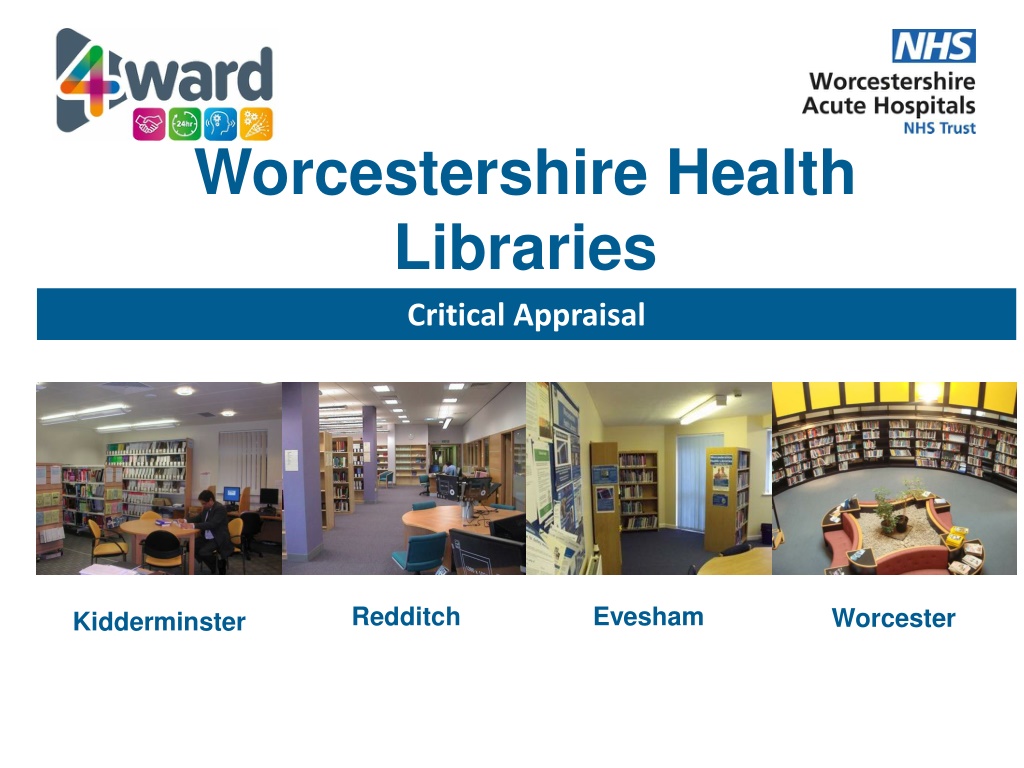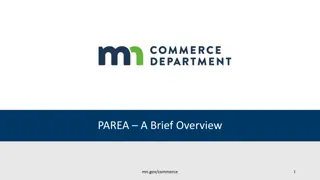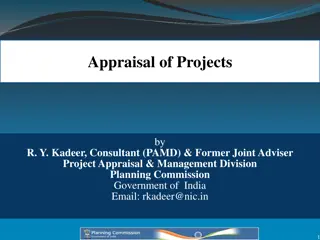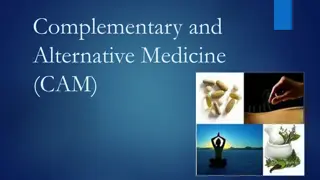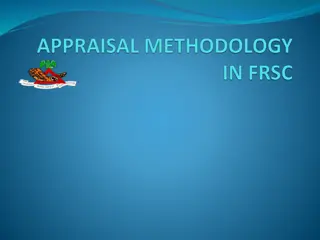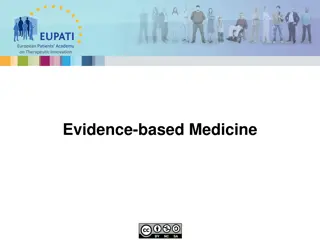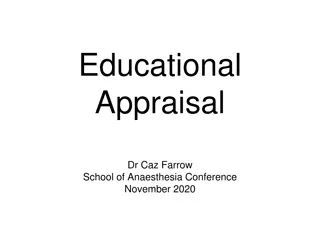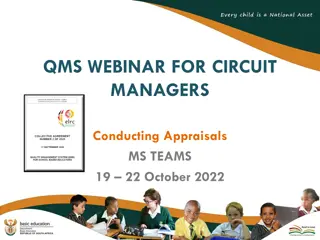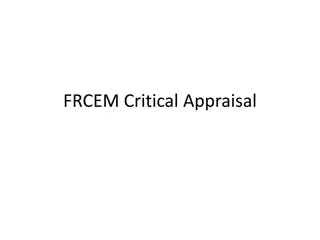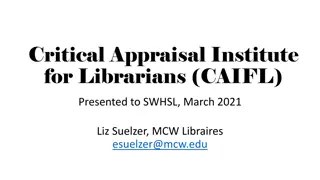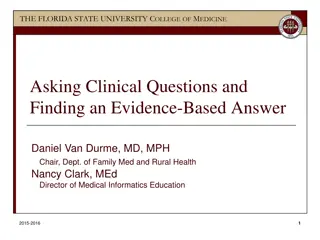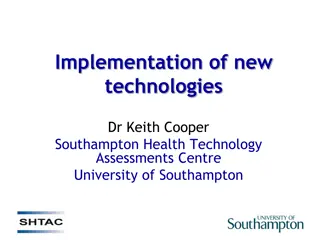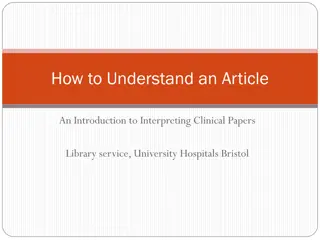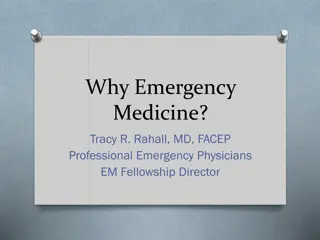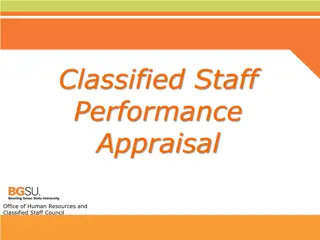Understanding Evidence-Based Medicine and Critical Appraisal in Healthcare
Dive into the world of Evidence-Based Medicine (EBM) and Critical Appraisal to enhance clinical care. Explore resources, learn to evaluate research, and apply the CASP framework for better patient outcomes. Discover why critical appraisal is essential and how to navigate the hierarchy of evidence in healthcare research.
Download Presentation

Please find below an Image/Link to download the presentation.
The content on the website is provided AS IS for your information and personal use only. It may not be sold, licensed, or shared on other websites without obtaining consent from the author. Download presentation by click this link. If you encounter any issues during the download, it is possible that the publisher has removed the file from their server.
E N D
Presentation Transcript
Worcestershire Health Libraries Critical Appraisal Redditch Evesham Worcester Kidderminster
Evidence Based Medicine Critical Appraisal "Evidence-based medicine refers to the application of the best available research to clinical care, which requires the integration of evidence with clinical expertise and patient values BMJ Best Practice
Shameless plug www.wkp.nhs.uk
What we are going to do Refresh memory on EBM Locate some useful resources Read through an article Apply the CASP questions
Why Critical Appraise? Basic Evidence-Based Medicine Clinical Audit gold standard Reflection To be a better clinician To offer the best treatment to an individual patient
What do you critical appraise? Any resources that you use: Websites, Point of Care/ Evidence summaries, articles, databases, opinions, guidelines, patient information and pathways
How to critical appraise? Critical appraisal of published research: introductory guidelines. BMJ 1991;302:1136 Evidence based medicine: a movement in crisis? BMJ 2014;348:3725 Critical Appraisal Skills Program http://www.casp-uk.net/ CASP eleven question approach to trial articles - Are the results valid? - What are the results? - Are they applicable? Or https://www.sign.ac.uk/what-we-do/methodology/checklists/ Centre Evidence Based Medicine https://www.cebm.ox.ac.uk/resources
Hierarchy of Evidence Diagram from Research Square
Different papers different questions? There are different types of research (RCTs, Systematic reviews, Cohorts ) So there are different questions to ask to deal with Bias Look at CASP and/ or SIGN for the different questions http://www.casp-uk.net/ https://www.sign.ac.uk/what-we- do/methodology/checklists/
Critical Appraisal Critical appraisal of any study design must assess: Validity Were sound scientific methods used? Chance / Bias / Confounding Factors Results What are the results and how are they expressed? Relevance Are the findings generalisable can they be applied to settings / situations outside the research study? Do these results apply to my local context?
Potential Errors of research Chance A random error appearing to cause an association between an intervention and an outcome. Probability of a random error is estimated using statistics (p values & confidence intervals) Bias The deviation of results from the truth due to systematic error in the research methodology. E.g: Selection Bias may result in the sample being unrepresentative Measurement Bias issues related to how the outcome was measured e.g Instrument bias, recall bias, Attention bias Intervention Bias differences in the how the treatment was carried out or subjects exposed to the factor of interest e.g Timing bias, withdrawal bias, Contamination bias Confounding Factors Where part of the observed relationship between two variables is due to the action of a third variable Known confounders: e.g. age, gender, smoking, etc.
Probability How precise are the results? A Probability value is a statement of how likely something is to be by chance. A probability value of 1 would mean it was entirely due to chance. A probability of 0.5 would mean it had a 50% chance of being due to chance. The magic figure that a study should reach is 0.05, which means there is only a 5% likelihood of a result being due to chance. The lower the figure the better, so 0.005 would be very unlikely to be due to chance. Generally, look for P<0.05 (1 in 20)
Confidence Intervals An alternative way of assessing the effects of chance The result of the trial is a point estimate if you ran the trial again you will get a different result The Confidence Interval gives the range in which you think the real answer The 95% CI is the range in which we are 95% certain that the true population value lies If the confidence intervals for individual studies overlap with this line, it demonstrates that at the given level of confidence their effect sizes do not differ from no effect for the individual study. Look at how wide the interval is, and the values at each end Individual sample size Combined Results Best Estimate Confidence Interval FavoursControl
Look at an article Moscati, R.M et al (2007) A multicenter comparison of tap water versus sterile saline for wound irrigation. Academic emergency medicine. 14(5) p.404-409 Read it through Go through the CASP questions
1. Population: >17 yrs with uncomplicated skin lacerations requiring staple or suture repair. Lots of specific exclusions. Abstract and p. 405 Study Setting & Population Did the study address a clearly focused question? Intervention: Irrigation with tap water in sink or with normal saline using a sterile syringe. Abstract and p. 405 Study Protocol Outcome: Wound infection rates. Abstract The measurement of outcome is limited to wound infection. There is no measurement of other outcomes, such as patient satisfaction with the procedure, pain during the procedure, duration of procedure etc. Comment from College of Emergency Medicine appraisal
2. interventions randomised? Was the assignment of participants to Randomised using envelopes that had been pre-randomised using computer-based random number generator. P.405 Study Protocol Randomisation by numbered envelopes can be subverted. The recruiting clinician can throw away the allocated envelope and pick up a new one if they do not want to follow the randomisation. This can be detected by ensuring that all envelopes are accounted for at the end of the trial, but there is no mention of this being done. The imbalance in numbers between the two groups (374 v 339) could have been caused by medical providers discarding envelopes randomised to tap water or could simply be due to chance. Comment from College of Emergency Medicine appraisal Similarity of groups discrepancy in group size discussed above. Other factors shown in two tables p.407 tables 1 and 2
3. accounted for at its conclusion? Were all participants who entered the study They calculated their own attrition rate as 15% and actual dropout rate was below this (10% - not mentioned). P405 Data analysis and p406 Figure 1. Dropouts explained p406 Results and figure 1. Intention to treat analysis not discussed. An assessment of the people taking part in a trial, based on the group they were initially (and randomly) allocated to. This is regardless of whether or not they dropped out, fully adhered to the treatment or switched to an alternative treatment. NICE
4. given? Were the investigators blind to the intervention they were giving to participants? Were the people assessing/analysing outcome/s blinded ? Were the participants blind to intervention they were Patients couldn t be blinded; Health professionals couldn t be blinded; Researchers Follow up staff blinded (p405 Study Protocol) although for follow up in emergency department (ED) and by phone patients could have told them (p408 Limitations)
5. Were the study groups similar at the start of the randomised controlled trial? Yes, testing a clearly defined intervention by comparing results in intervention and control group. Abstract and p. 405 Study Design Two clearly defined groups (tap water and saline) and criteria P. 405 Study Setting and Population
6. each study group receive the same level of care (that is, were they treated equally)? from the experimental intervention, were the groups treated equally? Apart from the experimental intervention, did Saline group treated by health professional Tap water group treated by self and not supervised so could have irrigated for longer or shorter time. P405 Study Protocol Same questions asked for follow up in ED and by phone. No figures on how many in each group were followed up by phone rather than in person. P405 Study Protocol and p408 Limitations
7. comprehensively? Power calculation was done and said they needed 1000 people but only 713 recruited. P405 Data Analysis and p406 Figure 1 Were the effects of intervention reported Low numbers discussed in Limitations and suggestion made that the data could be used in a meta-analysis. This was later done by Cochrane P408 Limitations Unusually there is no table showing results. Results were reported in terms of risk (3.3% in saline group, 4% in tap water group) and both absolute risk (0.7%) and relative risk (1.21) worked out. P406 Results, top paragraph, RH column. Have not done numbers needed to treat but have applied costs to figures which show that treating with tap water is cheaper even at the worst case scenario. (At upper end of CI where wound infection rates would be greater and extra costs of e.g. antibiotics needed). P405/6 Results
8. intervention or treatment effect reported? Was the precision of the estimate of the Confidence intervals are reported but not p-values. P406 Results Stated that CIs were being worked out on comparison of proportions so results would be statistically significant if CI didn t cross 1. P405 Data analysis CI calculated on both Absolute risk reduction and relative risk and neither showed statistical significance. In both cases the CI crosses 1 showing that at some point the results could be the same in the two groups. Relative risk: 1.21 (95% CI 0.5 to 2.7) (At 0.5 the infection rate in the tap water group was half that in the saline group; at 2.7 the infection rate in the tap water group could be more than twice that in the saline group). Absolute risk: 0.7% (95% CI -2.24% to 3.64%) P406 Results and p407 Discussion paragraph 1
9. Do the benefits of the experimental intervention outweigh the harms and costs? Have to remember significant exclusions made (p405 Study Setting and Population) so results can only apply to those with uncomplicated skin lacerations. Cost calculations are based on accepting the worst case scenario, (upper end of CI) (p407 Results) but should you be using a treatment where the results (on the measured outcome, i.e. wound healing) could actually be worse than on the control, just because it is cheaper? If they raise the underpowering, this comment from CEM appraisal: it would take an unfeasibly large study to increase statistical power substantially. It is unlikely that a mega-trial of tap water versus sterile saline would be funded .
10. Can the results be applied to your local population/ in your context? Eight million traumatic wounds treated per year USA Wound infection common complication. Cost, clinician time and risk mentioned. P. 404
10. greater value to the people in your care than any of the existing interventions? Participate time saved? Can you re-invest any time saved Participate clinician time increased/ reduced? Participate satisfaction? Would the experimental intervention provide Other considerations: Were the taps drinking water quality? What was the temperature of the water? What was the age and nutrition status of the participants as this can affect wound healing? Data on other outcomes: patient satisfaction with procedure; pain during procedure etc?
Would you change your practice on the basis of what you have just read?
Overview Ask a focused question Research the evidence Critically appraise evidence for its validity, effect size and precision Apply the evidence in practice
Thank you Any questions? David Chamberlain Library & Knowledge Services Manager David.Chamberlian2@nhs.net
